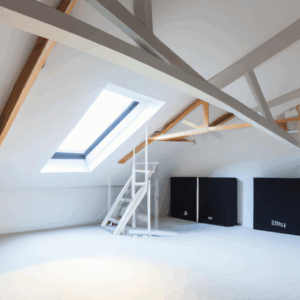How are armored cable guard strip requirements in attics changed by the 2023 NEC?
Overview
| Armored Cables (AC cables) are typically routed through accessible attics using structural elements like joists, which provide support for both the attic floor and ceiling. NEC Section 320.23 specifies the installation requirements for AC cables in these spaces. It mandates that AC cables running across framing members or within 7 feet of the floor must be protected by guard strips. However, if the space lacks permanent access, protection is required only within 6 feet of the entry point. In the 2023 NEC revision, this section was updated to replace “joists” with “framing members” and clarified that AC cables can be installed across both attic floor and ceiling structures. |  |
Applying the 2023 Code
Armored Cables, commonly known as AC cables, are integral in electrical installations for providing robust, protected pathways for electrical conductors. In accessible attics—spaces situated above the main ceiling but beneath the roof—structural elements such as joists are typically employed to route these cables. Joists are horizontal members within the attic structure that support the load of both the attic floor and ceiling. This routing is crucial for preserving the integrity of the electrical system by safeguarding the cables from physical damage and facilitating straightforward access for maintenance and repairs.
Previous versions of the NEC provided detailed guidelines for installing AC cables in accessible attics. Section 320.23(A) stipulated that AC cables running across the top of floor joists or within 7 feet of the floor, as well as across the face of rafters or studding, must be protected by guard strips. If access to the space was not provided by permanently installed stairs or ladders, this protection was only required within 6 feet of the scuttle hole or attic entrance. Section 320.23(B) exempted cables installed parallel to rafters, studs, or ceiling/floor joists from needing guard strips or running boards, provided they complied with 300.4(D). However, the prevalence of ceiling joists in most accessible attics led to confusion and the widespread practice of installing AC cables on the attic ceiling rather than the floor, even when the latter might be more appropriate. To clarify these installation practices, the 2023 NEC revised Section 320.23 by substituting “joists” with “framing members”. This change clarifies that both floor and ceiling installations are acceptable, improving safety and efficiency in electrical installations within accessible attics.
What’s New for the 2023 NEC?
The table below presents a comparison between the 2020 NEC and the 2023 NEC regarding Section 320.23.
| 2020 NEC | 2023 NEC |
| 320.23 In Accessible Attics
Type AC cables in accessible attics or roof spaces shall be installed as specified in 320.23(A) and (B). (A) Cables Run Across the Top of Floor Joists Where run across the top of floor joists, or within 2.1 m (7 ft) of the floor or floor joists across the face of rafters or studding, the cable shall be protected by guard strips that are at least as high as the cable. Where this space is not accessible by permanently installed stairs or ladders, protection shall only be required within 1.8 m (6 ft) of the nearest edge of the scuttle hole or attic entrance. (B) Cable Installed Parallel to Framing Members Where the cable is installed parallel to the sides of rafters, studs, or ceiling or floor joists, neither guard strips nor running boards shall be required, and the installation shall also comply with 300.4(D). |
320.23 In Accessible Attics
Type AC cables in accessible attics or roof spaces shall be installed as specified in 320.23(A) and (B). (A) Cables Run Across the Top of Framing Members Where run across the top of framing members, or across the face of rafters or studding within 2.1 m (7 ft) of the floor or horizontal surface, the cable shall be protected by guard strips that are at least as high as the cable. Where this space is not accessible by permanently installed stairs or ladders, protection shall only be required within 1.8 m (6 ft) of the nearest edge of the scuttle hole or attic entrance. (B) Cable Installed Parallel to Framing Members Where the cable is installed parallel to the sides of rafters, studs, or ceiling or floor joists, neither guard strips nor running boards shall be required, and the installation shall also comply with 300.4(D). |
